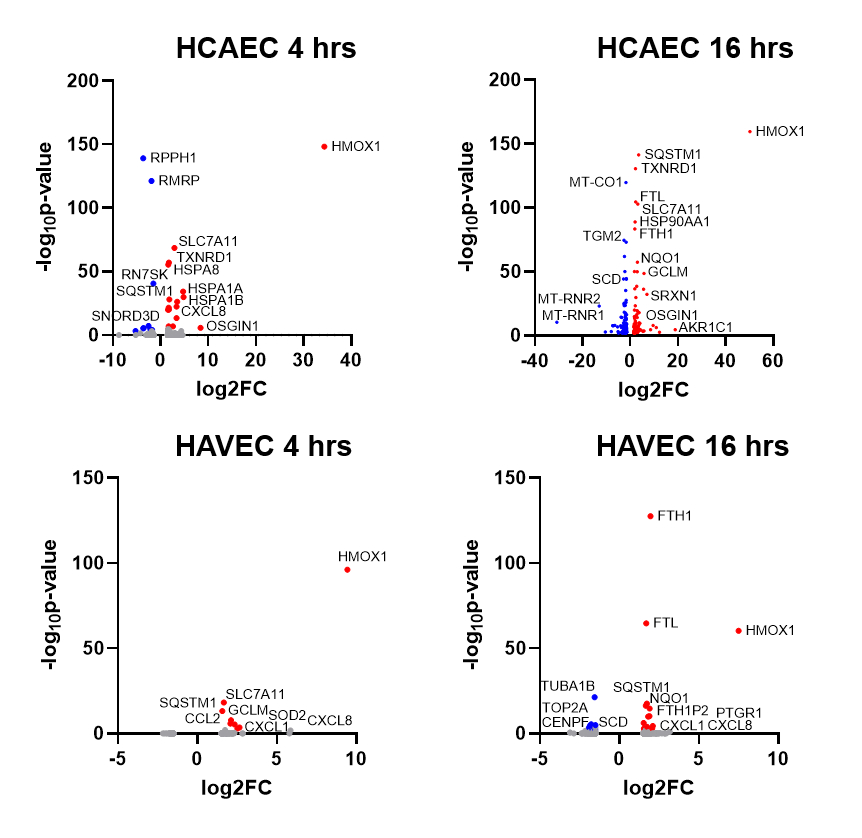Final ID: Tu0035
Lipoprotein(a) Induces a Proglycolytic and Proinflammatory Response in Coronary Artery and Aortic Valve Endothelial Cells, with Altered Metabolism and Reactive Oxygen Species Generation.
METHODS: Primary ECs were stimulated with 250 nmol/L Lp(a) or vehicle control for 2, 4, 8, and 16 hours (HCAEC) or 4, 8, and 16 hours (HAVEC). RNA was isolated, and global gene expression changes were examined by RNA-Seq (n=1). qRT-PCR was performed to validate Lp(a) effects on expression of selected genes. Additionally, the effect of Toll-like receptor (TLR) 2 and 4 and CD36 inhibition on Lp(a)-induced gene expression changes was assessed (n=3). Mitochondrial activity was measured by Seahorse assay, and ROS generation was quantified using commercially available assays.
RESULTS: RNA-seq analysis identified significant changes in HCAEC and HAVEC gene expression after Lp(a) treatment, with 1915 and 444 genes, respectively, identified as differentially expressed at 16 hours. KEGG pathway analysis showed significant (FDR < 0.05) enrichment in metabolic and proinflammatory signaling pathways, with distinct yet overlapping patterns in HCAEC and HAVEC. Interestingly, the most upregulated gene in both cell types was that encoding the stress response protein heme oxygenase-1 (HMOX-1), which was maximally induced by 50-fold in HCAEC and 7.5-fold in HAVEC. Moreover, Lp(a) increased mitochondrial activity, with a shift towards higher glycolysis, ROS generation, and ER stress in HCAEC. Lp(a)-induced expression of interleukin (IL)1a and selectin (SELE), but not HMOX1, was significantly (p<0.05) reduced with the inhibition of TLR2 and 4.
CONCLUSIONS: The relationship between Lp(a) and HMOX-1, ROS and metabolic stress, as well as TLR-induced proinflammatory pathways, illuminates the mechanisms by which Lp(a) induces endothelial dysfunction in cardiovascular disease, creating pathways for the development of new disease prevention and management strategies.
More abstracts on this topic:
Turner Mandy, Aikawa Elena, Itoh Shinsuke, Hoekstra Joost, Blaser Mark, Mikami Kentaro, Clift Cassandra, Muehlschlegel Jochen, Singh Sasha, Aikawa Masanori
A Remedy for the Heart and the Hemoglobin: Improvement in Anemia Post Transcatheter Aortic Valve ReplacementMatta Raghav, Roy Aanya, Hammad Bayan, Draffen Arvind, Natsheh Zachary, Tiu Daniel, Tiu David, Salem Edward, Balami Jesse, Kalagara Swetha, Gupta Neil, Uraizee Omar, Sahgal Savina, Mishra Atreya, Ene Adriana, Hattab Aleyah, Arora Aarushi, Sufyaan Humam, Dau Trang, Silberstein Jonathan, Yu Julia, Torres Kayla, Seshadri Suhas, Navarro Laura, Singam Manisha, Ismail Mariam, Rana Riya, Habeel Samer, Liu Simon, Chaganti Srinidhi, Gurbuxani Vidur, Dwyer Kaluzna Stephanie, Groo Vicki, Carlson Andrew, Shroff Adhir, Bhayani Siddharth, Khan Azmer, Bhattaram Rohan, Zhang Runze, Shah Pal

